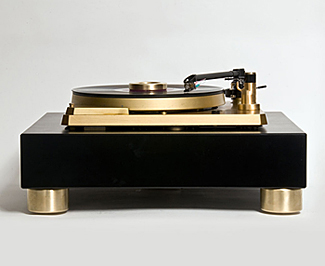
 Making Good Turntables Much Better
Making Good Turntables Much Better
• Brass mounting screws make any cartridge sound better. Ditto for removing the heat shrink on cartridge clips and treating the clips with SilClear.
• To get first rate sound and to get your money’s worth from any expensive cartridge, you MUST meticlously adjust VTA or tracking force every 3-4 months—that’s because stylus suspensions always sag with use. This lowers VTA and seriously kills dynamics and treble sparkle. Lots of people misinterpret this as a worn-out cartridge, an expensive error. Instead, raise VTA or lighten tracking force until your test record’s treble sounds too harsh, then drop VTA or lighten tracking force a hair. Your test record must not be thicker or thinner than the bulk of your record collection. Adjusting tracking force yields slightly better sonic results and longer cartridge life than adjusting VTA—and adjusting tracking force on most arms is WAY easier than adjusting VTA. For detailed, step-by-step instructions on the Mapleshade-developed tracking force approach to sag-compensation, click here.
• TT sound is surprisingly degraded by the rubber, plastic or composite rubber metal footers provided by the majority of turntable manufacturers. Replacing them with small wod blocks, preferably maple, is always an upgrade. The largest single TT upgrade I know comes from draining the TT’s internally-created vibrations via super-rigid, massive brass footers down into a thick maple receiving platform. The improvement in dynamics, tight bass, midrange harmonic detail and treble airiness is HUGE—even for light, low energy storage TTs like the Linn. Unsuspended TTs—anything from the little Regas to the most massive VPIs and Clearaudios—improve even more.
• Adding brass weights on points to TT plinths, armboards and motor housings can add 50% to the good effect of footers. Move weights and listen to find the sweet spots. Remember, adding too much kills all the gains.
• All TTs, whether using direct wall power or a power supply, are amazingly sensitive to AC cord quality. A fast transient, wide bandwidth cord like the Clearview Double Helix MK II cord can improve sound as much as doubling your cartridge investment; the Omega Mikro cords will go well beyond that. Even on budget Regas or Pro-jects, replacing the captive power cord with a squeeze-on Clearview AC Power Cord Kit is well worth doing.
• For TTs with a suspension, bypassing the springs is always a transforming improvement, particularly in the bass. This is most easily done by placing the TT plinth (i.e., the part resting on the springs) directly on brass footers tall enough to lift the old spring feet clear of the shelf or platform below—assuming space permits on the underside of the plinth. Later on, you can remove the springs completely to get rid of their resonance.
• If your TT has a free-standing motor, upgrading the motor’s feet is just as important as the upgrading the main TT’s mounting. Rubber feet are the worst possible mounting. IsoBlocks, in our experiments, are the best, better than brass footers. You can adjust the motor height by adding or removing IsoBlock laminations. For vibration control support of motor and TT, a single long custom maple platform, preferably 4”, is both practical and yields superb sound. However, to achieve the ultimate in resolution, use separate large platforms for motor and TT.
• On any TT where belt tension is adjustable, replacing the rubber belt with the thinnest possible dental floss—or, even better, silk thread—is a HUGE upgrade (provided the motor pulley is not so polished that the silk slips). Use a square knot to make the thread belt. To achieve best-sounding belt tension (whether rubber or thread), always loosen belt tension until your stroboscope disc just begins to show speed slippage, then tighten a smidge. This makes a big difference.
• Arm-wrapping with glass fiber, glass fiber reinforced tape (or an arm-wrapping kit) is a nice sonic improvement for most arms. Wrap super-tight.
• Correct grounding yields major sonic gains. Test by ear grounding the arm directly to the preamp, then separately grounding to the preamp any metal plate that’s part of the TT. Use the thinnest possible bare solid core copper wire. Listen to each ground wire in both directions; they’re always directional.
• Platter mats make a night and day difference in the sound of a turntable. Felt, rubber, foam or composite soft and highly damped platter mats always yield mushy bass and poor transient dynamics. For an immediate improvement, try each of the following: no mat, thin hard paper, hard manila folder cardboard, thin hard cork. To make meaningful listening comparisons, you MUST reset VTA for each mat. The choice of platter mat interacts strongly with the kind of record clamp or weight you are using; click here to learn about the ideas underlying the very best platter mat and record weight combination we’ve tested.
